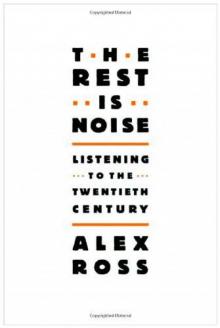The Rest Is Noise: Listening to the Twentieth Century 

by Alex Ross
Genre: Other10
Published: 2008
View: 7113
Read OnlineRead The Rest Is Noise: Listening to the Twentieth Century Storyline:
Amazon.com ReviewAnyone who has ever gamely tried and failed to absorb, enjoy, and--especially--understand the complex works of Schoenberg, Mahler, Strauss, or even Philip Glass will allow themselves a wry smile reading New Yorker music critic Alex Ross's outstanding The Rest Is Noise. Not only does Ross manage to give historical, biographical, and social context to 20th-century pieces both major and minor, he brings the scores alive in language that's accessible and dramatic.Take Ross's description of Schoenberg's Second Quartet, "in which he hesitates at a crossroads, contemplating various paths forming in front of him. The first movement, written the previous year, still uses a fairly conventional late-Romantic language. The second movement, by contrast, is a hallucinatory Scherzo, unlike any other music at the time. It contains fragments of the folk song 'Ach, du lieber Augustin'--the same tune that held Freudian significance for Mahler. For Schoenberg, the song seems to represent a bygone world disintegrating; the crucial line is 'Alles ist hin' (all is lost). The movement ends in a fearsome sequence of four-note figures, which are made up of fourths separated by a tritone. In them may be discerned traces of the bifurcated scale that begins Salome. But there is no longer a sense of tonalities colliding. Instead, the very concept of a chord is dissolving into a matrix of intervals."Armed with such a detailed aural roadmap, even a troglodyte--or a heavy metal fan--can explore these pivotal works anew. But it's not all crashing cymbals, honking tubas, and somber Germans stroking their chins. Ross also presents the human dramas (affairs, wars, etc.) behind these sweeping compositions while managing, against the odds, to discuss C-major triads, pentatonic scales, and B-flat dominant sevenths without making our eyes glaze over. And he draws a direct link between the Beatles and Sibelius. It's no surprise that the New York Times named The Rest Is Noise one of the 10 Best Books of 2007. Music nerds have found their most articulate valedictorian. --Kim HughesFrom Publishers WeeklyStarred Review. Ross, the classical music critic for the New Yorker, leads a whirlwind tour from the Viennese premiere of Richard Strauss's Salome in 1906 to minimalist Steve Reich's downtown Manhattan apartment. The wide-ranging historical material is organized in thematic essays grounded in personalities and places, in a disarmingly comprehensive style reminiscent of historian Otto Friedrich. Thus, composers who led dramatic lives—such as Shostakovich's struggles under the Soviet regime—make for gripping reading, but Ross treats each composer with equal gravitas. The real strength of this study, however, lies in his detailed musical analysis, teasing out—in precise but readily accessible language—the notes that link Leonard Bernstein's West Side Story to Arnold Schoenberg's avant-garde compositions or hint at a connection between Sibelius and John Coltrane. Among the many notable passages, a close reading of Benjamin Britten's opera Peter Grimes stands out for its masterful blend of artistic and biographical insight. Readers new to classical music will quickly seek out the recordings Ross recommends, especially the works by less prominent composers, and even avid fans will find themselves hearing familiar favorites with new ears. (Oct.) Copyright © Reed Business Information, a division of Reed Elsevier Inc. All rights reserved.Pages of The Rest Is Noise: Listening to the Twentieth Century :